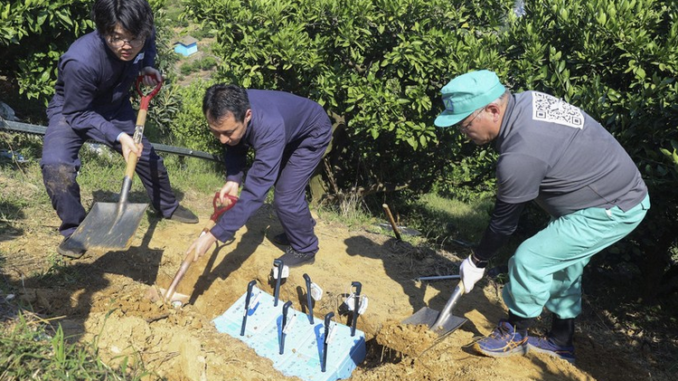
Matsuyama, Japan—Researchers at the Tokyo University of Agriculture and Technology and Shikoku Electric Power Co. are conducting an experimental project exploring the potential of soil microbes for use in fuel cells amid expectations that they could serve as a clean, long-lasting, and affordable power source.
Microbial fuel cells are devices that generate electricity using bacteria that release electrons as they consume organic materials. Electrogenic microbes, such as those from the Shewanella species, are said to be present in nearly all types of soil on Earth.
Although it was discovered over 100 years ago that microorganisms in soil release electrons, low power output has remained a key challenge in advancing the technology toward practical application.
The trial, which began in September at two citrus fields in Ehime Prefecture in western Japan, will continue until the end of March. The team plans to study how seasonal and climatic changes impact electricity output.
The project aims to use microbial fuel cells to power thermal sensors and cameras in agricultural fields and other locations.
The fuel cell used in the experiment is a 7-centimeter-high box filled with soil from the fields, with embedded electrodes. The team buried 12 such boxes at a depth of about 30 cm, covering them with soil in each of the two fields in Yawatahama and Ikata.
The electricity output will be small and will be used once a sufficient amount has been stored.
Microbial fuel cells “can be installed anywhere and don’t need to be replaced with new ones regularly,” said Keisuke Matsumura, a specially appointed assistant professor at the university in the Japanese capital. “They can become an alternative power source to solar power and dry cells.”
If the electricity can be used to power cameras for monitoring fields and thermal sensors, it will help reduce the burden on farmers in a country struggling with a declining farming population, he suggested.
In microbial fuel cells, electrons released by the microbes are first collected at the anode embedded in the soil before moving to the cathode. The flow of electrons through the circuit generates power.
“The mechanism of fuel cells is simple. We may be able to provide (electricity) at a reasonable price,” said Hiroyuki Mishima of Shikoku Electric based in Ehime Prefecture.


Be the first to comment